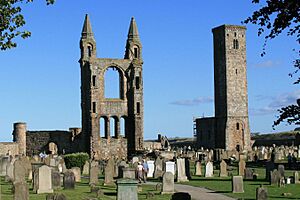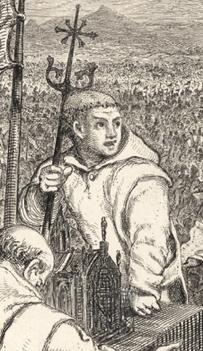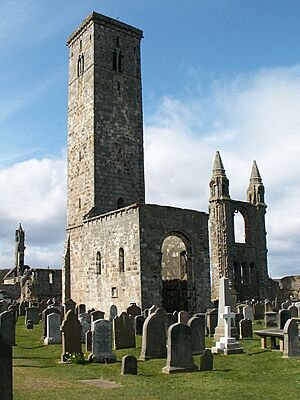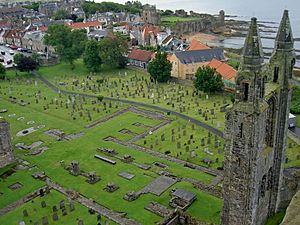St Andrews Cathedral facts for kids
Quick facts for kids St Andrews Cathedral |
|
|---|---|
| The Cathedral of St Andrew | |

East tower of St Andrews Cathedral and St Rule's Tower
|
|
| 56°20′24″N 2°47′15″W / 56.3400°N 2.7875°W | |
| Location | The Pends, St Andrews, Fife KY16 9QL |
| Country | Scotland |
| Denomination | Catholic |
| History | |
| Status | Ruined |
| Founded | 1158 |
| Founder(s) | Ernald |
| Dedication | Andrew the Apostle |
| Dedicated | 1318 |
| Relics held | Bones of St Andrew |
| Architecture | |
| Architectural type | Church |
| Style | Romanesque, Gothic |
| Groundbreaking | 1158 |
| Completed | 1318 |
| Closed | 1561 |
| Specifications | |
| Length | 391 ft (119 m) |
| Width | 168 ft (51 m) |
| Height | 100 ft (30 m) |
| Number of spires | 1 (fell in the 16th century) |
| Administration | |
| Archdiocese | Archdiocese of St Andrews |
The Cathedral of St Andrew, often called St Andrews Cathedral, is a famous ruined church in St Andrews, Fife, Scotland. It was built way back in 1158 and became a very important place for the Catholic Church in Scotland during the Middle Ages. It was where the main bishop of St Andrews worked.
But in the 1500s, during a time called the Scottish Reformation, Catholic services were no longer allowed. Because of this, the cathedral was left to fall apart. Today, Historic Environment Scotland looks after its ruins. Even as ruins, you can tell it was huge! It was about 119 meters (391 feet) long, making it the biggest church ever built in Scotland.
Contents
The Story of St Andrews Cathedral

Building a Grand Church
The cathedral was started because the older church of St. Regulus wasn't big enough. This older church, which was on the same land, was built in a style called Romanesque. Today, you can still see its tall, square tower, which is 33 meters (108 feet) high.
Work on the new, much larger cathedral began in 1158. It took over a century to build! A big storm blew down the west end of the church between 1272 and 1279, so it had to be rebuilt.
The cathedral was finally finished in 1318. It had a central tower and six smaller towers. You can still see two of these smaller towers at the east end and one at the west end, standing 30 meters (100 feet) tall. On July 5th, 1318, the cathedral was officially opened with King Robert the Bruce there. Legend says he even rode his horse up the aisle!
Later, in 1378, a fire damaged part of the building. It was repaired and made even more beautiful by 1440. The cathedral was home to a group of priests called Augustinian Canons. They were like the successors to the older Celtic church group called the Culdees.
When the Cathedral Became a Ruin
In June 1559, during the Scottish Reformation, a large group of Protestants, inspired by the preacher John Knox, attacked the cathedral. They destroyed the inside of the building. After this attack, the cathedral was no longer used and people started taking stones from it to build other things in the town. By 1561, it was completely abandoned and left to fall apart.
Around the end of the 1500s, the central tower collapsed, bringing down part of the north wall. More parts of the ruins were taken away for building. Nothing was done to protect the ruins until 1826. Since then, it has been carefully looked after. Today, you can still see the east and west ends, most of the south wall, and part of the west wall.
Some of the buildings where the priests lived, called the priory, were still standing in the late 1600s. Now, almost all of them are gone, except for parts of the priory wall and some archways known as The Pends.
St Rule's Tower
St Rule's Tower is on the cathedral grounds, but it's actually much older than the cathedral itself. It was part of the church that stood there before the big cathedral was built. This older church was kept so people could continue to worship while the new, larger cathedral was being constructed.
The tower and the part of the church next to it were built in the 11th century. They were meant to hold the special bones, or relics, of St Andrew. The rest of that old church is no longer standing.
Legend says that St Rule brought the relics of St Andrew to this area from Greece. Today, if you climb the tower, you get an amazing view of the town, the harbor, the sea, and the countryside. The tower is made of grey stone and is very tall for its age (33 meters). It was a landmark that could be seen from far away, helping pilgrims find their way to the relics of the Apostle. In the Middle Ages, it even had a spire on top, making it even taller!
Important People Buried Here
Many important people were buried at St Andrews Cathedral or in its churchyard.
Inside the Cathedral
- William de Lamberton (died 1328), a bishop who helped rebuild the cathedral.
- James Kennedy (bishop) (died 1465), buried in a grand tomb he built.
Cathedral Burial Ground
- Robert Chambers, a famous publisher.
- Adam Ferguson, an important Scottish thinker.
- Young Tom Morris, a legendary golfer.
- Old Tom Morris, another legendary golfer and father of Young Tom.
- Saint Andrew (some of his remains).
Eastern Cemetery
- Col Robert Hope Moncrieff Aitken, who received the Victoria Cross for bravery.
- Warington Baden-Powell, who started the Sea Scouts.
- Wilhelmina Barns-Graham, a well-known artist.
See also
 In Spanish: Catedral de St. Andrews para niños
In Spanish: Catedral de St. Andrews para niños




